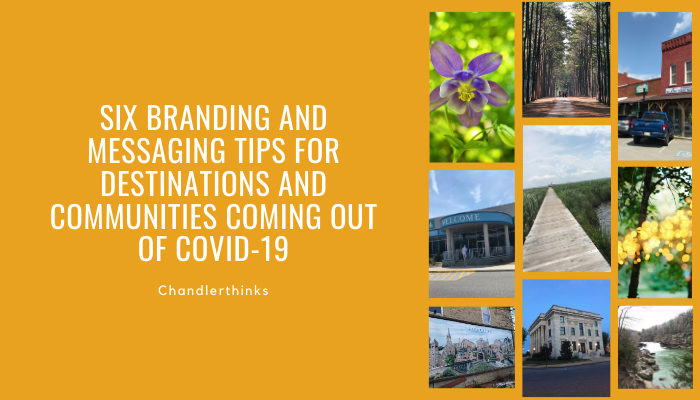Six Branding and Messaging Tips for Destinations and Communities Coming Out of Covid-19
During a crisis one of the biggest questions marketers have is, “when is it safe to resume communications and what can I say?” Like you, we’ve been listening to webinars and attending online meetings quite often. These questions are always a part of the conversation. We’ve spoken to tourism leaders and city administration officials in […]

During a crisis one of the biggest questions marketers have is, “when is it safe to resume communications and what can I say?” Like you, we’ve been listening to webinars and attending online meetings quite often. These questions are always a part of the conversation. We’ve spoken to tourism leaders and city administration officials in Louisiana, North Carolina, Alabama, Tennessee and Kentucky. A few themes are starting to emerge in the process of preparing to resume marketing initiatives (beyond the already daily and weekly updates). Here are six things for destinations and communities to consider when preparing to relaunch your messaging and branding.
1. Strong branding matters
Stronger brands will make it out of crisis better than those that lack identity. I’m not talking about logo identity. A brand identity is much more than a logo, it’s actually a brand story. A strong brand story can stir or ignite the positive emotions residents and visitors have towards your destination or city. It is what makes people proud of a community. It can rally and unite people together. It is, after all, what makes your destination unique.
Now is also a good time to relaunch new branding efforts. It can create renewed energy from within a community. It can send a message that you are not just emerging out of a crisis, but you are also determined to come back strong.
A brand story versus a logo.
A brand story is flexible. A logo is rigid.
A brand story can pivot directions without changing its identity. A logo cannot.
A brand story can live on indefinitely. A logo is defined and set.
A brand story can include and be used by as many that choose to tell it.
A brand story can be expressed through all the senses: sight, sound, taste, touch and smell. A logo is only visual.
During a crisis, a brand’s true authenticity and personality are revealed.
2. Show Empathy and Compassion
It’s quite normal to feel emotional while going through and coming out of a crisis. And it certainly isn’t necessary to remind people what we’ve all just experienced. We have all heard “through these uncertain times,” and “we’re here for you” enough in national advertisements. Get on with your message, but choose your words carefully so as not to appear insensitive.
3. Micro over Macro
As you communicate coming out of this crisis, the more your messaging needs to be targeted to those closest to your destination (locals and stakeholders). You should address what is most relevant concerning today and this week (not how great things will be several months from now. Recent leisure marketing research from Destinations International show 74% of DMOs are currently only marketing to their own community and the majority, 53%, believe June-Aug is when they expect to market tourism beyond the local community. When speaking to visitors, talk about your destination where it is right now. What can be done if visiting today and over the next 30 days? If you are a long-term booking destination, show them what it is like today. Actions taken today can create confidence that when they do visit, it will be ready. There are many unknowns that are likely to occur over the next several weeks.
4. Communicate Experiences with Space
Focus on assets and experiences that provide space and natural social distancing, such as outdoor activities (hiking, biking, beach strolling, canoeing, camping, etc.) It’s a good time to promote drive-in movie theatres if you have one. Messages to incorporate into your communications: Wide open. Physical distance. Space. Room. Freedom. Avoid communications that show or suggest long lines, crowds or groups.
5. Safety Talking Points Are Now Priority
What steps are you or your community taking to create a safer experience? Are there local government restrictions that visitors need to know? It’s not just about managing expectations, it’s also about making them feel safe. Talk to your local officials and stakeholders (retailers, attractions, and hotels) about what short-term changes they are making in their operations. Residents and visitors will need to know these important facts in order for them to make informed consumer decisions.
When you are talking about accommodations, cleaning protocols must be included, regardless if a strong program was already in place. Brand the cleaning steps to make it easy to promote, such as a “ 5-Point Cleaning Guarantee”. At first, consider a 24-hour cleaning period for each room turn-around, communicating no rooms are rented two days in a row.
6. Don’t Be Afraid To Have Fun
If you are promoting tourism, the idea of escaping to have a little fun should resonate and likely be much appreciated. If you are a city administrator, anything that can remind residents of what they love about your town will be cherished and welcome. Great destinations and great cities are all about having fun. So, don’t’ be afraid to let it show. We’ve heard enough sad piano keys to last us a lifetime. Display some energy and communicate your confidence that despite the changes and new normal ahead, we’ll still able to enjoy life. Perhaps, even more abundantly.
Everything in marketing is changing daily. If you have more thoughts, differing views or just want to reach out to say hello, please email steve@chandlerthinks.com.
Stay safe and go get ‘em!
Back to Thoughts